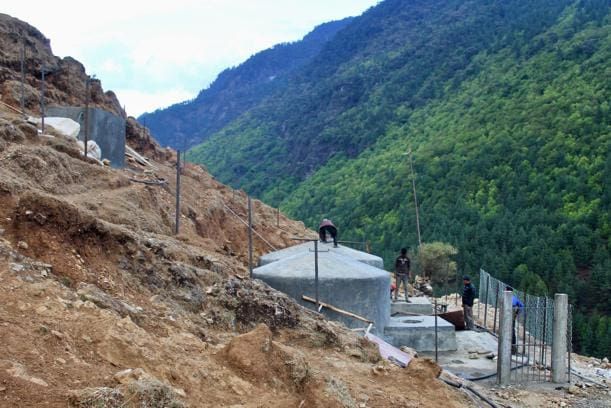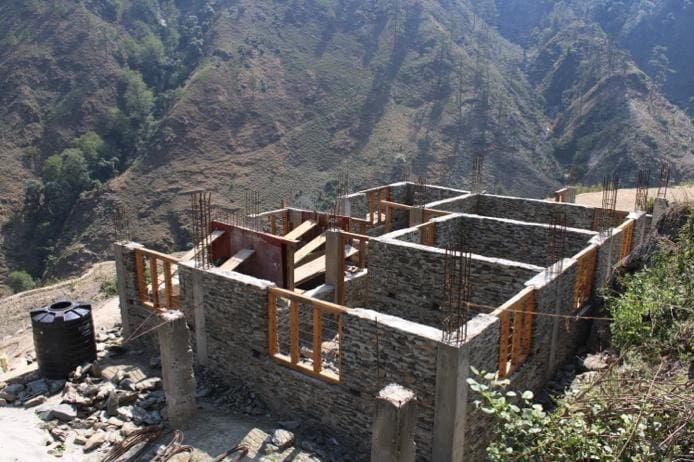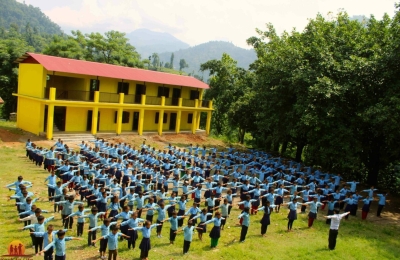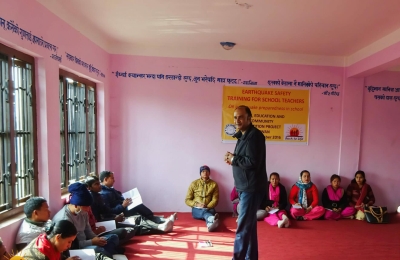Construction Projects in Nepal
We only build together
Back to Life does not buy or own land in Nepal. We are concerned with helping people to help themselves. We require the villages to take the initiative: The building site for a birthplace or a school must be provided by the respective village community. A local committee of women and men is formed and is firmly involved in all planning and work. The village community actively participates in the construction, for example, digging the foundation, bringing stones and wood. Each family sends one person to the construction site. This strengthens personal responsibility.















Where we build
In the rural and remote areas of Nepal, the health and education infrastructure is inadequate. The further you get into the mountains, the thinner the infrastructure becomes. We permanently strengthen the population where they need it most. Where several villages come together and many households are within reach, we build birth centers, schools and create access to water. Our on-site civil engineer draws the plans, we calculate the costs and apply for an official building permit.
How we build
Building earthquake-resistant houses in the mountains of Nepal is an immense challenge. It is pure handwork. Roads are few in the outlying areas of Mugu. Our birth centers and schools are often very remote, deep in the mountains. All building material must first be extracted from quarries or rivers and forests and laboriously carried over narrow mountain paths to the construction site. There, the boulders are chiseled by hand to fit the masonry. Stone by stone. In the absence of electricity, no machines can be used. For the skilled construction workers, the months of work in the remoteness of the high mountains is hard, since they are not all from the mountains. The interior furnishings of the rooms are carpentered locally in the villages, and the medically necessary equipment is brought from the lowlands to the mountains. Of course, with every construction, whether it is a school or a birth center, we ensure access to clean water, adequate sanitation and solar power.
How long does it take?
The construction time is usually around a year and is highly dependent on weather and weather conditions. Both in the monsoon and in winter, work often comes to a halt because persistent rain or heavy snowfall make construction operations impossible. The severe restrictions imposed by the Corona Lockdown have made our 2020 construction projects more difficult, but have not brought them to a halt. Especially the construction sites in the high mountains require more strength and organizational skills during the pandemic. However, once the construction is completed, the entire village community rejoices in the joint success.
Ongoing Construction Projects 2023:

Birth Center Libru
More Info
-
Projekt
Birth Center Libru
-
Location
Mugu -
Start Date
December 2022 -
End Date (Planned)
December 2023

Birth Center Maha
More Info
-
Projekt
Birth Center Maha
-
Location
Mugu -
Start Date
February 2023 -
End Date (Planned)
May 2024

Lamru Secondary School
More Info
-
Projekt
Lamru Secondary School
-
Location
Mugu -
Start Date
October 2023 -
End Date (Planned)
October 2024

Watersystem Sinekhola
More Info
-
Projekt
Wassersysteme Sinekhola
-
Location
Mugu -
Start Date
January 2023 -
End Date (Planned)
June 2024

Watersystem Khayalche
More Info
-
Projekt
Watersystem Khayalche
-
Location
Mugu -
Start Date
April 2023 -
End Date (Planned)
September 2024

Watersystem Gamtha
More Info
-
Projekt
Watersystem Gamtha
-
Location
Mugu -
Start Date
January 2023 -
End Date (Planned)
July 2024

Birth Center Nera
More Info
-
Projekt
Birth Center Nera
-
Location
Mugu -
Start Date
December 2022 -
End Date (Planned)
October 2024

Birendranagar Hospital
More Info
-
Projekt
Birendranagar Hospital
-
Location
Mugu -
Start Date
November 2022 -
End Date (Planned)
December 2023

Primary School Satbada
More Info
-
Projekt
Primary School Satbada
-
Location
Mugu -
Start date
December 2022 -
End Date (Planned)
December 2023

Watersystem Ratapani
More Info
-
Projekt
Watersystem Ratapani
-
Location
Mugu -
Start Date
December 2024 -
End Date (Planned)
September 2025

Watersystem Gayalpani
More Info
-
Projekt
Watersystem Gayalpani
-
Location
Mugu -
Start Date
July 2023 -
End Date (Planned)
December 2024

Birth Center Tali Kalai
More Info
-
Projekt
Birth Center Tali Kalai
-
Location
Mugu -
Start Date
December 2022 -
End Date (Planned)
November 2024

Kawa Secondary School
More Info
-
Projekt
Kawa Secondary School
-
Location
Mugu -
Start Date
December 2022 -
End Date (Planned)
December 2023

Primary School Tali Kalai
More Info
-
Projekt
Primary School Tali Kalai
-
Location
Mugu -
Start Date
December 2022 -
End Date (Planned)
December 2023

Watersystem Karka Jamir
More Info
-
Projekt
Watersystem Karka Jamir
-
Location
Mugu -
Start Date
April 2024 -
End Date (Planned)
September 2025

Watersystem Sirupata
More Info
-
Projekt
Watersystem Sirupata
-
Location
Mugu -
Start Date
October 2023 -
End Date (Planned)
March 2025








A typical Back to Life birthing center has a birthing room, one for convalescence, a “pharmacy” (supply room), an office and dormitory for the midwives, separate restrooms for normal operations and the birthing patients. In addition, an installed tank donates running water, there is continuous solar power with battery system, hot water and a kitchen. We have attached a playground to some birthing centers, because many pregnant women already have children who like to use it while their mothers visit the birthing center for checkups
What have we achieved so far?
Earthquake-resistant School Buildings with 147 Classrooms
Birth Houses in the high Mountains
Houses rebuilt after Fire Disaster
Buildings built so far in Nepal
Water Systems and 1 micro Waterworks
Biogas Plants















